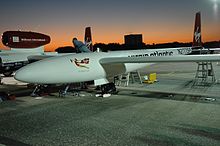
In aerospace engineering, an aircraft's fuel fraction, fuel weight fraction, or a spacecraft's propellant fraction, is the weight of the fuel or propellant divided by the gross take-off weight of the craft (including propellant):
The fractional result of this mathematical division is often expressed as a percent. For aircraft with external drop tanks, the term internal fuel fraction is used to exclude the weight of external tanks and fuel.
Fuel fraction is a key parameter in determining an aircraft's range, the distance it can fly without refueling. Breguet’s aircraft range equation describes the relationship of range with airspeed, lift-to-drag ratio, specific fuel consumption, and the part of the total fuel fraction available for cruise, also known as the cruise fuel fraction, or cruise fuel weight fraction.
In this context, the Breguet range is proportional to
Fighter aircraft
At today’s state of the art for jet fighter aircraft, fuel fractions of 29 percent and below typically yield subcruisers; 33 percent provides a quasi–supercruiser; and 35 percent and above are needed for useful supercruising missions. The U.S. F-22 Raptor’s fuel fraction is 29 percent, Eurofighter is 31 percent, both similar to those of the subcruising F-4 Phantom II, F-15 Eagle and the Russian Mikoyan MiG-29 "Fulcrum". The Russian supersonic interceptor, the Mikoyan MiG-31 "Foxhound", has a fuel fraction of over 45 percent. The Panavia Tornado had a relatively low internal fuel fraction of 26 percent, and frequently carried drop tanks.
Civilian Aircraft
Airliners have a fuel fraction of less than half their takeoff weight, between 26% for medium-haul to 45% for long-haul.
| Model | MTOW (t) | OEW (t) | OEW Fraction |
Fuel capacity (t) |
Fuel fraction |
Payload Max. (t) |
Payload fraction |
|---|---|---|---|---|---|---|---|
| Airbus A380 | 575.0 | 285.0 | 49.6% | 254.0 | 44.2% | 84.0 | 14.6% |
| Boeing 777-300ER | 351.5 | 167.8 | 47.7% | 145.5 | 41.4% | 69.9 | 19.9% |
| Boeing 777F | 347.8 | 144.4 | 41.5% | 145.5 | 41.8% | 102.9 | 29.6% |
| Boeing 777-200LR | 347.5 | 145.2 | 41.8% | 145.5 | 41.9% | 64.0 | 18.4% |
| Boeing 767-300F | 186.9 | 86.1 | 46.1% | 73.4 | 39.3% | 54.0 | 28.9% |
| Airbus A350-1000 | 322.0 | 155.0 | 48.1% | 124.7 | 38.7% | 67.3 | 20.9% |
| Airbus A350-900 | 283.0 | 142.4 | 50.3% | 110.5 | 39.0% | 53.3 | 18.8% |
| Airbus A350F | 319.0 | 131.7 | 41.3% | 131.7 | 41.3% | 111.0 | 34.8% |
| Boeing 787-9 | 254.7 | 128.8 | 50.6% | 101.5 | 39.9% | 52.6 | 20.7% |
| Airbus A330-300 | 242.0 | 129.4 | 53.5% | 109.2 | 45.1% | 45.6 | 18.8% |
| Airbus A330-200 | 242 | 120.6 | 49.8% | 109.2 | 45.1% | 49.4 | 20.4% |
| Airbus A330-200F | 233 | 109.4 | 47.0% | 109.2 | 46.9% | 68.6 | 29.4% |
| Boeing 787-8 | 227.9 | 120.0 | 52.7% | 101.3 | 44.4% | 41.1 | 18.0% |
| Airbus A320ceo | 79 | 44.3 | 56.1% | 23.3 | 29.5% | 20 | 25.3% |
| Boeing 737-800 | 79 | 41.4 | 52.4% | 20.9 | 26.5% | 21.3 | 27% |
| Bombardier CS300 | 70.9 | 37.1 | 52.3% | 17.3 | 24.4% | 18.7 | 26.4% |
| Bombardier CS100 | 63.1 | 35.2 | 55.3% | 17.5 | 27.7% | 15.1 | 23.9% |
| McDonnell Douglas MD-11F | 286.0 | 112.7 | 39.4% | 117.4 | 41.0% | 92.0 | 32.2% |
| Ilyushin IL-76TD-90VD | 195.0 | 92.5 | 47.4% | 90.0 | 46.2% | 50.0 | 25.6% |
| Boeing 747-8F | 447.7 | 197.1 | 44.0% | 181.6 | 40.6% | 132.6 | 29.6% |
| Concorde | 185.1 | 78.7 | 42.5% | 95.7 | 51.7% | 12.7 | 6.9% |
| Virgin Atlantic Globalflyer | 10.1 | 1.6 | 16.1% | 8.4 | 82.9% | 0.1 | 1.0% |
General aviation
The Rutan Voyager took off on its 1986 around-the-world flight at 72 percent, the highest figure ever at the time. Steve Fossett's Virgin Atlantic GlobalFlyer could attain a fuel fraction of nearly 83 percent, meaning that it carried more than five times its empty weight in fuel.
See also
References
- Brandt, Steven (2004). Introduction to Aeronautics: a Design Perspective. AIAA (American Institute of Aeronautics & Ast). p. 359. ISBN 1-56347-701-7.
- Vinh, Nguyen (1993). Flight Mechanics of High-Performance Aircraft. Cambridge: Cambridge University Press. p. 139. ISBN 0-521-47852-9.
- Filippone, Antonio (2006). Flight Performance of Fixed and Rotary Wing Aircraft. Elsevier. p. 426. ISBN 0-7506-6817-2.
- 8200/27900 = 0.29
- The F-22 Program FACT VERSUS FICTION Archived 2007-04-21 at the Wayback Machine by Everest E. Riccioni, Col. USAF, Ret.
- Spick, Mike (2002). Brassey's Modern Fighters. Washington: Potomac Books. pp. 51–53. ISBN 1-57488-462-X.
- "A380 Aircraft Characteristics – Airport and Maintenance Planning" (PDF). Airbus. December 2016.
- ^ 777-200LR/-300ER/-Freighter Airplane Characteristics for Airport Planning (PDF) (Technical report). Boeing. May 2015.
- ^ "A350 Aircraft Characteristics – Airport and Maintenance Planning" (PDF). Airbus. November 2016. Archived from the original (PDF) on 2016-11-28.
- ^ "787 Airplane Characteristics for Airport Planning" (PDF). Boeing. December 2015.
- ^ "A330 Aircraft Characteristics – Airport and Maintenance Planning" (PDF). Airbus. December 2016.
- "A320 Aircraft Characteristics – Airport and Maintenance Planning" (PDF). Airbus. June 2016.
- "737 Airplane Characteristics for Airport Planning" (PDF). Boeing. September 2013.
- ^ "CSeries brochure" (PDF). Bombardier. June 2015. Archived from the original (PDF) on 2015-09-08. Retrieved 2017-10-22.
- "Concorde Airframe". heritage-concorde. Retrieved 2024-03-17.
- ^ "Virgin Atlantic Global Flyer | National Air and Space Museum". airandspace.si.edu. Retrieved 2024-03-17.
- Noland, David (February 2005). "Burt Rutan and the Ultimate Solo". Popular Mechanics. Archived from the original on 2006-12-11.

